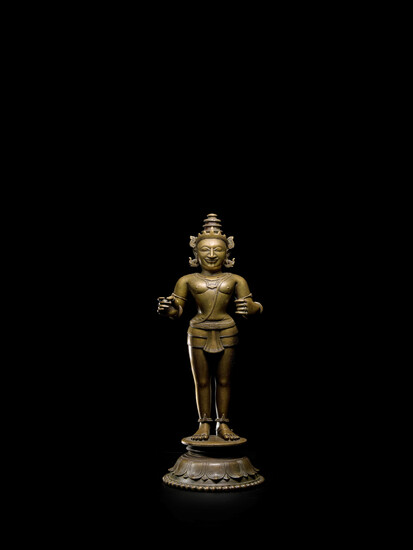A BRASS FIGURE OF RAMA ORISSA, CIRCA 16TH CENTURY
A BRASS FIGURE OF RAMA
ORISSA, CIRCA 16TH CENTURY16 1/4 in. (41.2 cm.) high
ProvenanceAcquired in the New York art market, 1990s.Among the alternative perspectives on the male form offered by India's great philosophical and artistic traditions is the portrayal of masculine physical strength, not as realized musculature, but as latent immovable mass within a supple physique. This ideal is embodied by this triumphant figure of Rama, standing upright and firmly planted with a lightly-clad wrestler's build.This hero, known to every Indian child and after whom Thai kings are named, manifested on earth as an avatar of the Hindu god Vishnu to thwart the excessive power of the demon-king Ravana and restore order to the universe. He subsequently reigned over a golden age of human existence. Rama is depicted here with an expression of unwavering confidence. The arms extending from his formidable shoulders are raised in a manner which would have once held a bow and arrow, separately cast attributes that are typically lost in these sculptures.Arriving from a high point of metal casting in Orissa, Northeastern India, the present figure of Rama is notably larger than most in this style. An auspicious composition of metals resulting in its alluring, honeyed tone were prescribed in order for the deity to want to temporarily inhabit the figure when called upon. The adornment of rings around each finger, thumb, and toe, and the well-kept hair bun visible from behind, are both signifiers of artistic quality and a sculpture worthy enough to beckon a god.A closely related Orissan sculpture of Radha was published in Dehejia, Devi, The Great Goddess: Female Divinity in South Asian Art, Smithsonian Institution, 1999, p. 329, cat no. 77, and later sold at Sotheby's, New York, 21 March 2019, lot 917. The treatment of the circular, tiered lotus base and the lotiform design of the jewelry are nearly identical. The facial features are also similar—the wide eyes, prominent nose, and the full, smiling lips, all beneath a discreet singular brow line.
View it on
Estimate
Time, Location
Auction House
A BRASS FIGURE OF RAMA
ORISSA, CIRCA 16TH CENTURY16 1/4 in. (41.2 cm.) high
ProvenanceAcquired in the New York art market, 1990s.Among the alternative perspectives on the male form offered by India's great philosophical and artistic traditions is the portrayal of masculine physical strength, not as realized musculature, but as latent immovable mass within a supple physique. This ideal is embodied by this triumphant figure of Rama, standing upright and firmly planted with a lightly-clad wrestler's build.This hero, known to every Indian child and after whom Thai kings are named, manifested on earth as an avatar of the Hindu god Vishnu to thwart the excessive power of the demon-king Ravana and restore order to the universe. He subsequently reigned over a golden age of human existence. Rama is depicted here with an expression of unwavering confidence. The arms extending from his formidable shoulders are raised in a manner which would have once held a bow and arrow, separately cast attributes that are typically lost in these sculptures.Arriving from a high point of metal casting in Orissa, Northeastern India, the present figure of Rama is notably larger than most in this style. An auspicious composition of metals resulting in its alluring, honeyed tone were prescribed in order for the deity to want to temporarily inhabit the figure when called upon. The adornment of rings around each finger, thumb, and toe, and the well-kept hair bun visible from behind, are both signifiers of artistic quality and a sculpture worthy enough to beckon a god.A closely related Orissan sculpture of Radha was published in Dehejia, Devi, The Great Goddess: Female Divinity in South Asian Art, Smithsonian Institution, 1999, p. 329, cat no. 77, and later sold at Sotheby's, New York, 21 March 2019, lot 917. The treatment of the circular, tiered lotus base and the lotiform design of the jewelry are nearly identical. The facial features are also similar—the wide eyes, prominent nose, and the full, smiling lips, all beneath a discreet singular brow line.



